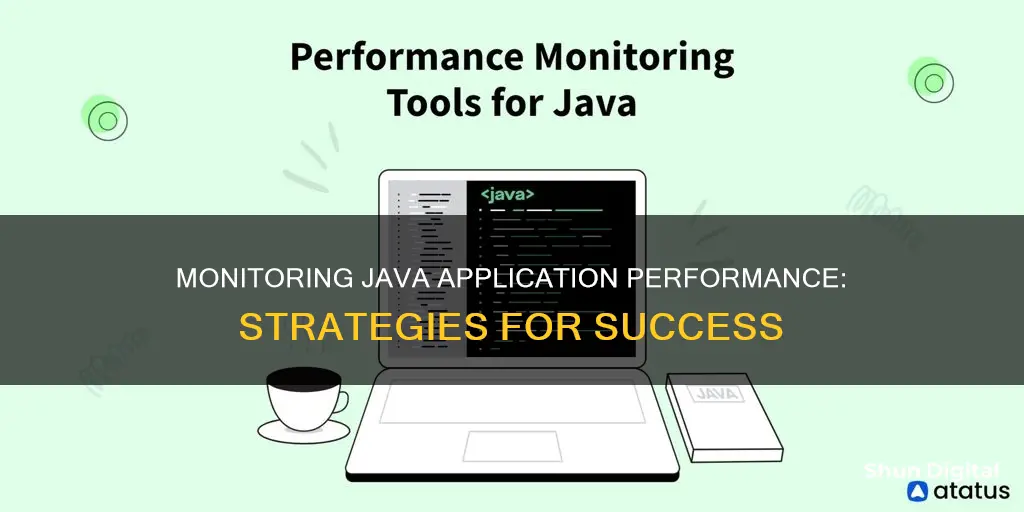
Java is a widely-used programming language for creating and deploying web applications and platforms. Its versatility and ease of use have made it a popular choice for developers, but this also means that reliable performance monitoring is essential to maintain high standards. Monitoring Java applications is not a straightforward process, and several techniques are required to track Java logs, metrics, infrastructure data, and other operational aspects. This article will discuss the best practices and tools for effective Java application performance monitoring.
| Characteristics | Values |
|---|---|
| Tools | SolarWinds AppOptics, SolarWinds Server & Application Monitor, Eclipse Memory Analyzer, LightStep, EJ Technologies JProfiler, Pingdom Server Monitor, Sematext Experience, AppDynamics, Java Mission Control, Java Flight Recorder, jcmd utility, JConsole, jmap utility, jps utility, jstack utility, jstat utility, jstatd Daemon, visualgc Tool, Stagemonitor, VisualVM, JavaMelody |
| Techniques | Code Profiling, Transaction Tracing, Optimize Logging Libraries, Find and Fix Performance Bottlenecks, Track Exceptions |
| Metrics | Memory, Threads, Classes, JMX metric, MBeans, Heap, Garbage Collection, Response Time, CPU, Disk I/O, Throughput, Exception Rate |
What You'll Learn

Code profiling
There are two types of Java code profiling tools: sampling profilers and instrumentation profilers. Sampling profilers collect data at fixed intervals, while instrumentation profilers involve adding extra code to measure program performance.
Standard Java Profilers
Standard Java Profilers provide visibility into all JVM metrics, including memory, CPU, threads, and garbage collection. They track all method calls and memory usage, allowing developers to identify areas requiring the most CPU and memory resources. Examples include Java VisualVM, Oracle Java Mission Control, and NetBeans Profiler.
Lightweight Java Transaction Profilers
Lightweight Java profilers, such as xRebel and LightStep, track the performance of individual web requests or transactions by injecting themselves into the code. They provide in-depth data for everything JVM-related and can help detect what method calls influence response times. However, they are limited to monitoring applications during development, and an APM tool is needed for QA and production environments.
Java Profiling Tools
There are several Java profiling tools available, both open-source and commercial. Popular options include YourKit Java Profiler, Eclipse MAT (Memory Analyzer Tool), and VisualVM. VisualVM, for instance, is an open-source tool that combines several JDK tools into a single user interface, making it easier to monitor and troubleshoot applications. It provides insights into CPU and memory usage, helping developers identify potential bottlenecks and optimise their code.
Kia's Blind Spot Monitoring: Which Models Have This Feature?
You may want to see also

Transaction tracing
For example, developers can detect common issues like N+1 database query patterns caused by SQL queries being run in a loop. The instant feedback provided by transaction tracing tools helps developers validate that their code is functioning as expected.
EG Enterprise is another transaction tracing tool that provides complete visibility into distributed Java transaction processing across all tiers. It uses byte code instrumentation to tag and trace every transaction, capturing method invocations, processing times, and exceptions. This allows for easy isolation of the tier responsible for high transaction response times.
Overall, transaction tracing is a powerful technique for developers to optimise their code, identify performance bottlenecks, and ensure their applications are functioning efficiently.
Asus Monitor Lifespan: How Long Can You Expect Them to Last?
You may want to see also

Logging libraries
Log4j2
Log4j2 is a widely recognised successor to the original Log4j framework, offering significant improvements in performance and flexibility. It supports various output formats such as XML, JSON, and YAML, and can be configured using these formats. Log4j2's standout feature is its asynchronous logging capability, which minimises the impact on application performance, making it ideal for high-throughput applications. It also introduces six severity levels for logging methods: trace(), debug(), info(), warn(), error(), and fatal(), while also allowing custom level creation.
SLF4J (Simple Logging Facade for Java)
SLF4J serves as an abstraction layer, allowing developers to plug in different logging frameworks without changing the source code. This flexibility is valuable when switching between frameworks based on project requirements or when working on multiple projects with different logging systems. SLF4J does not provide a complete logging solution by itself, as it is only a facade, but it enables seamless transitions between logging frameworks.
Logback
Logback is considered the successor to the Log4j project and has gained popularity over the years. It offers faster performance, more concise configuration, and native support for JSON, XML, and HTML formats. Logback integrates well with SLF4J, providing a robust and modern logging solution. It consists of loggers, appenders, levels, and layouts, allowing for highly configurable and customisable logging.
JUL (Java Util Logging)
JUL is a straightforward and accessible logging option included in the JDK (Java Development Kit). While it may lack advanced features found in dedicated logging frameworks, JUL is suitable for simple applications or those seeking to minimise external dependencies. It includes handlers, filters, and formatters as part of its core logging functionalities.
Tinylog
Tinylog is an open-source logging framework introduced in 2012, known for its simplicity, ease of configuration, and lightweight design. It supports multithreaded applications, provides bindings for various logging libraries, and can be used with JVM, GraalVM, or Android. Tinylog is a good choice for basic logging needs, offering optimised speed and a straightforward learning curve.
Troubleshooting Slow ASUS Monitor Startup
You may want to see also

Performance bottlenecks
SolarWinds Server & Application Monitor (SAM) is another tool that can be used to monitor key performance indicators such as pool size, memory heap size, transaction response time, garbage collection, application uptime, and CPU usage. It can also help pinpoint and resolve performance issues, as well as detect any potential bottlenecks in real-time.
Another way to identify performance bottlenecks is by using transaction tracing software to trace application transactions. This is an effective way to get to the root cause of errors in Java logs.
Additionally, a strong understanding of JVM logging libraries can simplify the monitoring process and accelerate Java performance troubleshooting. Users with knowledge of logging libraries can effectively revisit log data for faster troubleshooting.
Furthermore, a JVM troubleshooting software can automate bottleneck detection and speed up the troubleshooting process.
Unlocking Locked Keys on Your ASUS Monitor
You may want to see also

Exception tracking
By definition, an exception is an event that occurs during the execution of a program that disrupts the normal flow of the program's instructions. They are used to indicate many different types of error conditions across all the application layers, including out of memory, stack overflow, IO problems, null pointer exceptions, and network timeouts.
When an exception occurs within a method, the method creates an object and hands it off to the runtime system. This exception object contains information about the error, including its type and the state of the program when the error occurred. This information can be used for early error detection and prevention, root cause analysis, reconstructing events after a problem, and identifying security problems.
Exception monitoring offers a way of gaining early insight into production problems. By monitoring exceptions, you can trace a performance issue to its root cause, thereby gaining the time and means to spot the problem before it reaches a tipping point and impacts your users or company.
From a security perspective, exception monitoring is also important. Attackers can use information exposed by error messages, such as stack traces, privacy information, and sometimes even passwords, to gain access to systems. Monitoring exceptions may be the best way to identify when a system is being hacked, as logs are often the only record that suspicious behaviour is taking place.
Java exception handling is managed via five keywords: try, catch, throw, throws, and finally. Program statements that might raise exceptions are contained within a try block. If an exception occurs, it is thrown and can be caught and handled in a catch block. Any exception that is thrown out of a method must be specified using a throws clause. Any code that must be executed after a try block is put in a finally block.
Ram Trucks: Blind Spot Monitor Feature Explained
You may want to see also
Frequently asked questions
JConsole and VisualVM are the most common free tools for monitoring Java applications. They are shipped with the standard Java JDK and provide metrics on memory, threads, classes, and KPI like JMX metric and MBeans. However, they lack application context and the ability to run in live production environments continuously.
AppDynamics, SolarWinds AppOptics, and SolarWinds Server & Application Monitor (SAM) are popular paid tools for monitoring Java applications. These tools offer more advanced features, such as continuous monitoring, real-time alerts, and integration with other platforms.
It is recommended to start with code profiling to isolate inefficiencies and regressions in the code. Transaction tracing is also useful for spotting Java log errors, and optimizing logging libraries can simplify the monitoring process. Additionally, it is important to detect and fix performance bottlenecks early by analyzing JVM performance metrics such as garbage collection, heap usage, and response time.
Key metrics to monitor include heap memory usage, garbage collection, response time, throughput, exception rate, and CPU, memory, and disk I/O. Monitoring these metrics can help identify potential issues and ensure optimal performance for Java applications.







